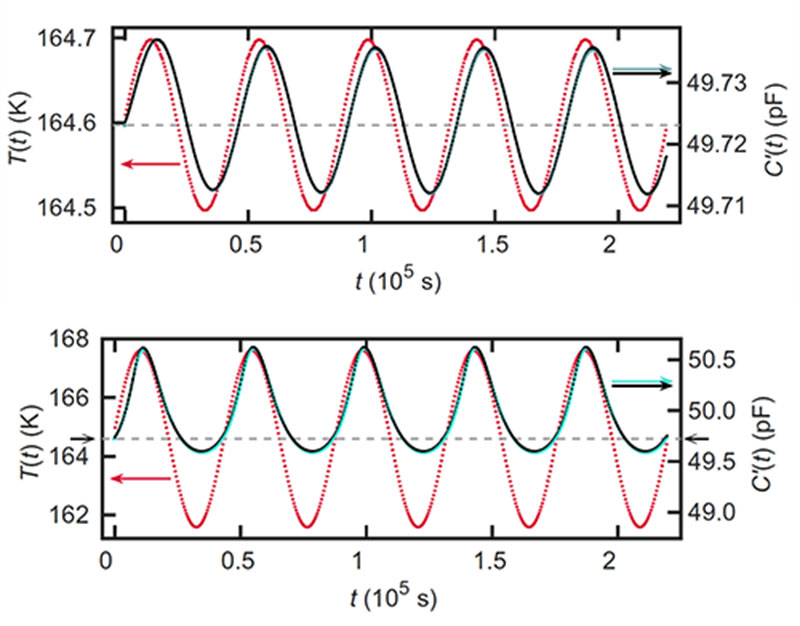Glass Ages in Material Time
Fall
2022
Feature
Glass Ages in Material Time
Christine Middleton, Physics Today
Follow a tour guide around a European city and you’re likely to hear the tale that old cathedral windowpanes appear uneven because over hundreds of years, the glass has slowly flowed toward the bottom of the pane. That story is just a myth; such flow in silica would require at least geologic time scales. But glassy materials, molecular and otherwise, do slowly evolve toward elusive equilibrium states—a process known as aging. And because they’re out of equilibrium, the process is nonlinear and history dependent, making the aging system’s behavior hard to model or predict.
 Like many physical processes, however, a glassy material’s response can be linear when it’s subjected to sufficiently small perturbations. In the 1970s, researchers proposed that such a material’s linear response—which can be described by existing theoretical frameworks—could also be used to understand its hard-to-capture nonlinear behavior. By their reasoning, if the same thermal rearrangements were behind the system’s evolution in both regimes, then the same response function should describe both. But in the nonlinear regime, the dynamics are slowed down and the laboratory time must be replaced by a so-called material time that proceeds at a rate that reflects the state of the sample.
Like many physical processes, however, a glassy material’s response can be linear when it’s subjected to sufficiently small perturbations. In the 1970s, researchers proposed that such a material’s linear response—which can be described by existing theoretical frameworks—could also be used to understand its hard-to-capture nonlinear behavior. By their reasoning, if the same thermal rearrangements were behind the system’s evolution in both regimes, then the same response function should describe both. But in the nonlinear regime, the dynamics are slowed down and the laboratory time must be replaced by a so-called material time that proceeds at a rate that reflects the state of the sample.
Subsequent theories have relied on the material-time framework to connect linear and nonlinear glass aging, even though the existence of such a time has never been directly validated by experiments. Now Birte Riechers and coworkers at Roskilde University in Denmark have made that connection in a glass-forming molecular liquid.1 After performing a series of careful measurements to determine the material’s response to small changes in temperature, they were able to accurately, and with no fit parameters, predict its behavior after larger temperature jumps.
In their first set of experiments, the researchers subjected a thin layer of the liquid to temperature jumps and tracked its evolution after each one. They measured the sample’s capacitance at 10 kHz as a proxy for its configurational evolution. The experiments were time consuming because the sample could take days or even weeks to equilibrate after a jump. They were also precise: a Peltier element kept temperature fluctuations to less than a millikelvin, and an ultraprecise capacitance bridge enabled resolution at the level of a hundredth of a picofarad.
The researchers determined the sample’s linear-response function by observing its evolution after small temperature jumps of less than 1 K and as small as 10 mK. Then they put the function to the test. The top graph in the figure confirms that the researchers were indeed observing the linear regime—the change in the temperature (red) produces a proportional change in the measured capacitance (green)—and demonstrates that the response function (black) could predict the sample’s behavior. The bottom graph shows the prediction of the response function after incorporating the material time. The larger-amplitude temperature oscillation brought the sample outside the linear regime, but the prediction and data still closely agree.
Deviations between the data and predictions began to appear when temperature jumps reached about 2.5 K. Based on that behavior, the researchers believe the material likely has two nonlinear aging regimes: an intermediate one, in which the same relaxation mechanisms are at play as in the linear regime, and a more extreme one, in which other processes contribute to the material’s response.
For a more in-depth discussion of this research, see the Physics Today article of the same name that appeared in the May 2022 issue, https://doi.org/10.1063/PT.3.4995.
Reference
1. B. Riechers et al., “Predicting Nonlinear Physical Aging of Glasses from Equilibrium Relaxation via the Material Time,” Sci. Adv. 8 (2022), DOI: 10.1126/sciadv.abl9809.
In honor of the International Year of Glass, Radiations is pleased to share this Physics Today article from March 29, 2022.
